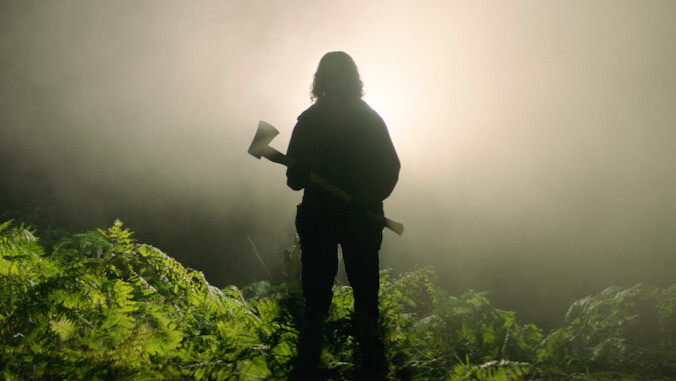Ben Wheatley’s eco-thriller In The Earth has one terrific scene and a lot of boring hooey


Note: The writer of this review watched In The Earth on a digital screener from home. Before making the decision to see it—or any other film—in a movie theater, please consider the health risks involved. Here’s an interview on the matter with scientific experts.
There’s one great scene lurking around the midway mark of In The Earth, the new movie from British cult filmmaker Ben Wheatley. A deceptively polite eccentric, Zack (Reece Shearsmith), has drugged and held captive a pair of strangers he’s stumbled upon in the woods. One of them has an infected wound on his foot. Should he take the poor bloke to the hospital? Nah, they’d never make it in time, Zack rationalizes. Better to solve the problem himself with his trusty, conveniently sharpened ax. Audiences may think, in this moment, of the big scene in Misery—there’s a comparable dread in the futile attempts to reason with a psychopath whose mind is made up. But Wheatley compounds the, well, misery with false starts and close calls, each precarious fall of the ax ratcheting up the delirious tension, until the moment reaches a fever pitch of peer-through-the-fingers anxiety. It’s a miniature master class of prolonged unease that gets you laughing at your own squeamish anticipation.
In The Earth could use more scenes like that. It could use more recognizable human behavior period, and less of just about everything else it offers: the endless wandering, the interminable bad-trip montages, the ecological mumbo jumbo that its characters spend long passages dryly discussing. This is a pandemic movie in more ways than one. It’s set during a global outbreak that isn’t COVID but, you know, is. And it was shot during the real one, over just 15 days last summer, mainly outdoors, with a small cast and crew. Though the dialogue occasionally addresses what could be described as the relatable issues of our time (“It’s odd, being outside for the first time in months,” someone muses), viral concerns prove to be little more than a catalyst for the bare-bones plot… or, rather, the trance-horror hooey that passes for one.
The man with the hurt foot is Dr. Martin Lowry (Joel Fry), a scientist accompanying a park ranger, Alma (Ellora Torchia), on a two-day trek to a research facility. Along the way, the two face threats both human and not. Besides their ax-wielding captor, there’s also a mysterious entity—a fabled nature god called Parnag Fegg that could have been ported over from the liner notes of a black metal album. Another researcher, Dr. Wendle (Hayley Squires), has discovered a way to communicate with it via flashing light and droning sound, both Wheatley specialties. Is she the travelers’ savior or a mad scientist plunging them into new trouble? In The Earth develops some rudimentary conflict among its small ensemble (there’s even the faint impression of a love triangle), but none of it takes root, because all the characters seem a little vegetative themselves, around mostly to photosynthesize exposition. Only the crazed Zack threatens to express a personality—it’s no coincidence that the movie perks up during his scenes. (Shearsmith, a veteran of this director’s whacked-out world, is creepily casual in his insanity.)
You never know exactly what you’re going to get, pressing play on a new film from this prolific merchant of shocks and schlock. Wheatley has made a crime drama, a folk-horror freakout, a deranged murder comedy, a Tarantino-esque shoot-’em-up, an uncharacteristically elegant J.G. Ballard adaptation, and a tony Hitchcock remake that almost no one—even his biggest fans—seemed to like much. His next film, supposedly and surprisingly, is a sequel to the dopey Jason Statham giant-shark potboiler The Meg. If there’s any precedent in that eclectic body of work for the general wackiness of this new entry, it’s probably his most flagrantly out-there genre excursion, the rambling, rural period piece A Field In England. When Wheatley isn’t cutting in close here on some gnarly mutilation of the flesh, he’s provoking people who have epilepsy with stuttering, shuttering psychedelic reverie—lots of flower-power hallucinations, flash-cut into ribbons and set to an ambient soundtrack by Clint Mansell that’s much more evocative than the material it’s accompanying. Which is to say, In The Earth feeds the indiscriminate appetites of gorehounds and bong-rippers alike. Everyone else may find it as ghastly boring as the violence is just plain ghastly.
Mostly, Wheatley benefits this time from the lowered expectations of our present moment: That he was able to safely make a movie at all is cause for some admiration, even if said movie amounts to little more than fucking around in the forest for a couple hours. “I wouldn’t try to make any logical sense of it,” someone remarks of the film’s mythology, in what might be intended as an instructive line, à la that comparable and widely quoted Tenet lampshade. But the movie doesn’t hold up to a ton of philosophical or thematic scrutiny either; its ideas about connection, both human and natural, are malnourished—a casualty of Wheatley’s indifference to anything but alternately narcotizing viewers and jolting them back up in their seats. Best to just cling to the stray traces of dry humor, including the comically episodic wringer Wheatley puts Martin and his vulnerable soles and toes through. If injury to the foot isn’t a phobia yet, it will be after enough people watch In The Earth.